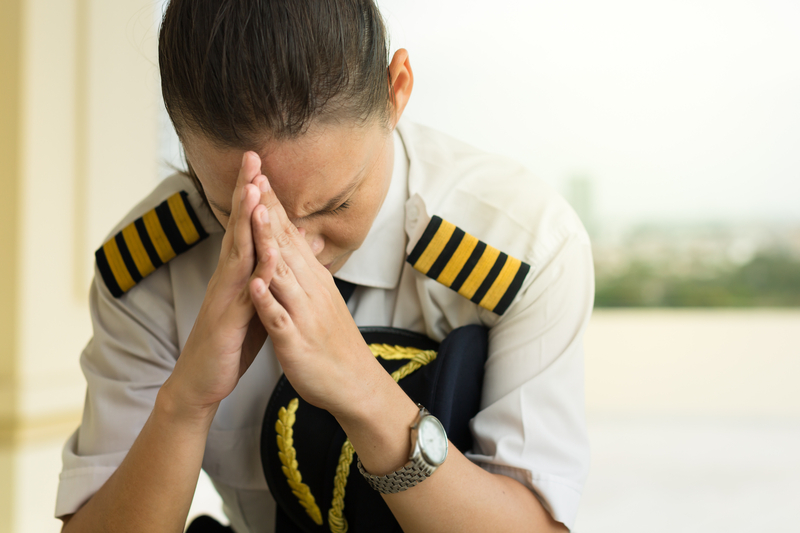As mentioned in the previous article, stress is a biological, psychological, and emotional response that we experience when we feel threatened or under pressure. Stress can be cumulative, for example a stressor can feel more stressful if you already have a lot of other stressors you are dealing with. A stressor is the stimulus which causes the experience of stress (e.g., an engine failure, last-minute operational changes, or a divorce stressor can affect a person even without that person being aware of the stressor. This might be more common than we think with commercial pilots, particularly when this stressor is a frequent occurrence. Recent research by Venus and Holtforth (2022) suggest that chronic stress appears to be linked to psychophysiological wear and tear, and is associated with higher levels of fatigue, more sleep disturbances and more impaired mental health.
Life Events and Daily Hassles
The Life Events Inventory (LEI) (Cochrane and Robertson, 1973) was developed as a checklist of potential stressful life events which may occur for individuals (Jackson, 2009). Bereavement, divorce, major injury/illness, marriage, moving house and having a baby are all examples of significant life events.
The daily hassles scale (DHS) was developed by Kanner et al. (1981) as an alternative to the stressful major life events inventories because it has been recognised that hassles are irritating, frustrating demands that occur during everyday transactions with the environment, which can build up as accumulative stressors (Holm and Holroyd, 1992). These include 117 items about health, health of a family member, losing things, finances, traffic, too many things to do, interrupted sleep and physical appearance (Kanner et al., 1981). Kanner et al. (1981) found that the DHS tended to be a more accurate predictor than the LEI of stress-related problems. Given the responsibilities and daily stressors involved in a pilot’s job, this seems a key consideration when investigating stress in aviation.
Pilots and stress
Many pilots, however, claim that they can compartmentalise effectively (i.e., to keep personal issues, feelings, and thoughts outside the cockpit) to maintain a high performance (Young, 2008). Yet, research suggests that high numbers of professional pilots may be severely fatigued, with some reporting significant sleep problems and burnout (Venus, 2020). Indeed, Bor, et al. (2002) suggested that various aspects of the pilot’s job (e.g., disrupted relationships, odd routines, and jet lag) may cause significant levels of stress.
Stress and Performance
Research suggests that individuals who are facing life stressors may have a higher likelihood of making errors, as their focus could drift onto their stressor rather than fully dedicating their cognitive resources to the current task (Young, 2008). Although pilots may possess the capability to prevent life stressors from affecting their performance in the flightdeck, each individual pilot also has a certain level of stress, or a particular stressor, that could greatly hinder their ability to compartmentalise (Neubauer, 1999). According to Christy (1975), even pilots who are considered high functioning, may experience a combination of intrapersonal or interpersonal stress. This can lead to the development of personality responses, anxiety or somatic symptoms that could ultimately result in reduced effectiveness and inadequate functioning. Furthermore, Loewenthal, et al. (2000) hypothesise that stress indirectly affects performance by disrupting sleep and impairing one‘s ability to pay attention.
Risks of Burnout
Given these regular and frequent daily stressors and reports of battling fatigue there is a high risk of burnout. Not only for pilots, but for trainers, instructors, cabin crew, operation controllers and air traffic controllers, amongst others in a high stress environment. Burnout is defined in ICD-11 as follows:
“Burnout is a syndrome conceptualized as resulting from chronic workplace stress that has not been successfully managed. It is characterized by three dimensions:
- feelings of energy depletion or exhaustion;
- increased mental distance from one’s job, or feelings of negativism or cynicism related to one's job; and
- reduced professional efficacy.
Burnout can result in mental fatigue, (emotional and physical) exhaustion, anxiety, and disconnection and can have serious implications for physical and mental health, relationships, and careers.”
There is a difference between burnout (which is related to your occupation) and depression (which seeps into all aspects of life). Burnout “occurs when what was once an enjoyable activity no longer becomes enjoyable because you've been under long-term constant stress” (Gould, 2012). Gould (2012) identifies 3 different types of stress:
- an internal source of stress – perfectionism, a personality factor that generates a constant stress to be perfect
- external sources of stress – e.g., commercial pressure, pressure to perform stemming from an over-bearing manager/captain
- physically created stress – related to training and/or poor recovery, e.g., lack of sleep and poor nutrition.

Like young protégé athletes, pilots can start training at a young age. Burnout can occur when such passionate, dedicated individuals become disillusioned with their career aspirations which they derived so much of their ‘pilot’ identity and meaning from. Having a narrow ‘pilot’ identity which individuals might be strongly attached to puts them at risk of burnout, similar to a narrow ‘athletic identity’ (Gustafsson et al., 2018). Try out an online burnout self-assessment tool drawn up by Mind Tools.
Underreporting
A common challenge to aviation safety is the reluctance of pilots to report physical complaints or illnesses, as they fear temporary grounding or negative impacts on their flying careers (Young, 2008). Despite experiencing significant life events, reports indicate that the majority of pilots continue to fly even when experiencing fatigue and mental health issues (Venus, 2020). Pilots may lack full awareness of the impact of stress on their daily lives and in response to significant life events (Young, 2008). Furthermore, even when they are aware of these effects, various internal and external pressures discourage pilots from reporting or seeking help for symptoms. These pressures include concerns about losing respect among fellow pilots, being seen as less reliable, or being taken off flight duty (Young, 2008). In fact, colleagues often discourage pilots from seeking mental health care altogether. This aversion to being interviewed by mental health professionals, as suggested by Bor et al. (2002), further complicates the investigation of the relationship between life stress, performance, and mental wellbeing among pilots.
Like athletes, pilots can be on a high-performance pathway where life is often unbalanced and “the rigour of training and being put under the pressure of achieving targets can affect some more than others.” (Grey-Thompson, 2017). Given the risks of higher levels of stress, degraded health and higher occupational accident risks associated with shift-work and insufficient sleep (Venus, 2020) it is important to work on breaking down barriers, improving understandings of pilot stressors and fears, and de-stigmatising mental health in aviation. This will help to improve our understanding of the risks of career burnout for pilots. Therefore, as an industry understanding how to prevent and recover from burnout is key when working to reduce the risks that lead to declining mental health for pilots. It is important to work on breaking down barriers, improving understandings of all air crew stressors and fears, eradicating toxic cultures, implementing and reinforcing a ‘just culture’, improving working conditions, providing safe and secure rosters for all air crew and de-stigmatising mental health in aviation.




Rate and Review
Rate this article
Review this article
Log into OpenLearn to leave reviews and join in the conversation.
Article reviews